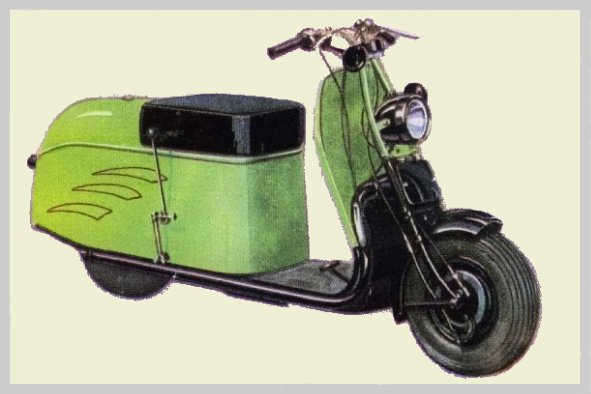
Frank Rainbow, a gifted aero engineer and industrial designer, keenly
interested in two-wheelers, was given the brief to produce a Villiers powered machine which
could be built using a minimum of tooling and equipment. The tubular steel loop chassis was
to be made in the Treforest works of Tube Investments, who also produced the Swallow sidecar
chassis.
The tubular frame of the Swallow Gadabout consists of a 1 3/4 in. diameter 16-gauge steel
tube running forward from each side of the rear wheel then curved upward to the steering head.
Joining the two side tubes are two traverse tubes, one forward and the other to the rear of
the engine.
The front wheel is supported by rigid tubes which formed the steering forks. Each side
member consists of two tubes telescoped into each other and welded into position with the
steering column brackets. At the top the side members are curved round to form the
handlebars. Rear suspension is also non-existent, relying on cushioning from the
low-pressure 4.00" x 8" rubber tyres.
Pressed steel wheels with split rims which can be separated for easy tyre removal are
non-interchangable, and both the front and rear wheels are fitted with cable operated
5" diameter drum brakes. The front brake is operated by a handlebar lever and the
rear by a pedal on the foot-board.
The Villiers 9D 125cc engine is direct air cooled through a duct below the foot board
and the gearbox is a 3-speed unit that is operated by hand via a lever situated on the
right-hand side behind the rider, a system which was dropped on the
Mark 2 model.
From its launch, the Gadabout came with a plywood seat base with a spring cushion overlaid
with horsehair and covered in black leathercloth. The flywheel cover on the first versions
was painted the same colour as the body. The rear stand has to be lifted up into place
when taking the scooter off its stand, when not in use the stand is held in position by a
clip on the underside of the body frame. An interesting feature, is a helpful oil
measuring jug built into the fuel tank cap to allow measurement of the exact amount of oil
needed for a fill up. All the bodywork is sheet steel, with access to the fuel tap and tools
under the seat. The Gadabout was available in six colours these being; grey, blue, green,
beige, red and maroon.
| Specification |
| Engine |
Villiers Mk 9D two-stroke, capacity 125cc.
50mm x 62mm
3.15 bhp |
| Carburettor |
Villiers "Junior" Type |
| Transmission |
Three-speed gearbox - handchange |
| Frame |
Welded twin tube with no rear suspension. |
| Forks |
Tube forks with no suspension. |
| Wheels |
Pressed steel 8" diameter with split rims |
| Tyres |
4.00 x 8" 16" overall diameter |
| Electrical |
Villiers 6 volt lighting equipment, headlight 5½ diameter |
| Fuel Tank |
Steel, located inside body, capacity 2¼ gallons |
| Brakes |
Drum brakes - 5" diameter on both wheels,
front operated by hand lever, rear by foot pedal. |
| Dimensions |
Wheelbase 50", ground clearance 4", unladen seat height 25" |
| Weight |
200lbs. |
| Performance |
Maximum speed 40 mph, cruising 30+ mph, 80 mpg |